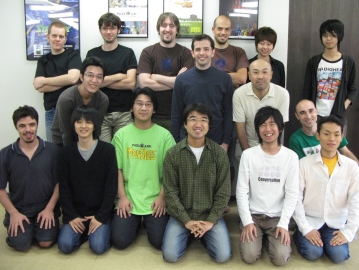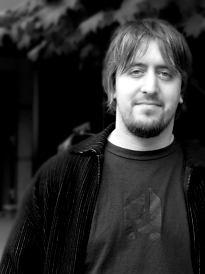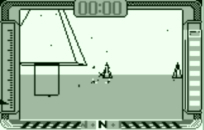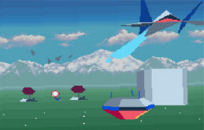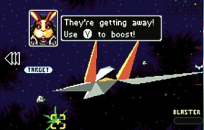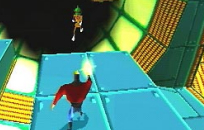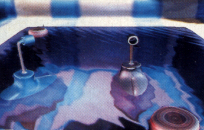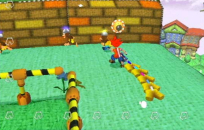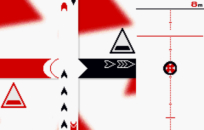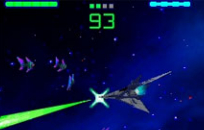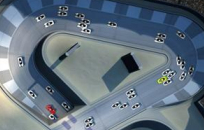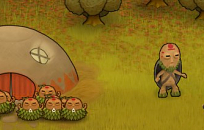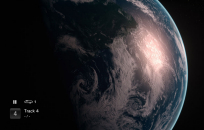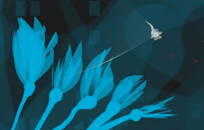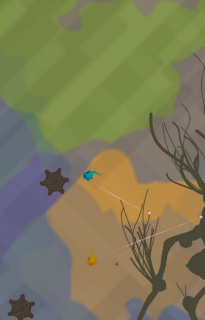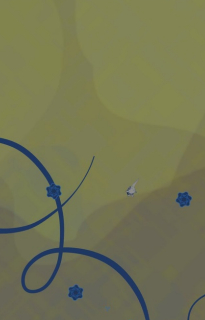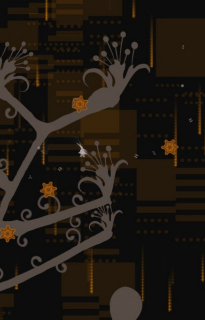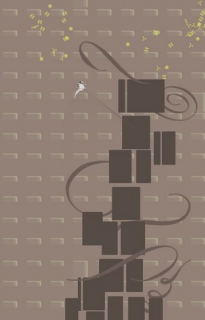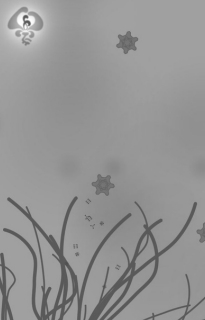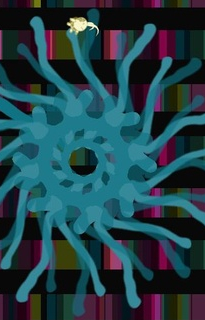Dylan Cuthbert
The creation of Eden - Part 2
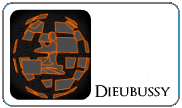
COREgaming
- 22 / 01 / 09
Founder of the Kyoto-based studio Q-Games, Dylan Cuthbert owns an enviable curriculum that includes the creation of some of the most groundbreaking videogames ever made. Fascinated by the power of 3D graphics from an early age, he became a part of the extinct Argonaut Software group where he invented, to the astonishment of all, the first ever fully tridimensional game to run on a handheld console.
This revolutionary Game Boy title named X became Cuthbert's passport from England to Japan, as Nintendo felt compelled to support and explore the potential of the young designer. Once settled in Kyoto, he was assigned to a top priority project running under the creative direction of Shigeru Miyamoto, where he was asked to build a program that would enable the Super Nintendo to display real time 3D graphics: the result was the trailblazing STAR FOX, a game that would later become the first episode of the highly acclaimed series.
Shortly after leaving Nintendo, he contributed to a number o relevant projects under Sony Computer Entertainment, namely in the research of technological resources and the design of technical demonstrations. His whimsical duck bathtub demo managed to enchant both the audience and the press at the E3 2000 unveiling of Sony's new console, the Playstation 2.
Following their collaboration in the production of the game PIPOSARU 2001, Cuthbert teams up with Kenkichi Shimooka for the establishment of the Q-Games, providing services to the two biggest console manufacturers in Japan. Their new and highly inventive Pixel Junk label is focused on the emergent market of downloadable games, while taking maximum advantage of high definition screen technology allowed by the Playstation 3 system.
After the release of RACERS and MONSTERS, the studio's newest endeavour included the special participation of the Kyoto artist Baiyon, interviewed in November for the first part of this article. In order to learn more about the process of creating EDEN, I had the great pleasure to interview Mr. Dylan Cuthbert, whom I asked about the perspectives and motivations behind the Q-Games ensemble. I thank Mr. Cuthbert from the bottom of my heart for finding the time to answer my questions.
-------------------------------------------------------------
COREGAMERS : One of the most striking changes that the videogame industry has shown in the last years is the growth of independent gaming with smaller, outstanding studios and creators being summoned by high profile companies that offer larger budgets. Where does Q-Games stand in this market?
Dylan Cuthbert : Q-Games is geared towards developing small to medium games, and not the big blockbuster type game that you see from larger studios. This is primarily because I personally don't want to develop that kind of big game. I much prefer to make smaller more... "concise" games.
I think these smaller games are where everything began and they are naturally more pleasant to work on for developers. I suppose it is the difference between big Hollywood movies and "art house" movies.
On the back (from left to right): Paul Leonard, Jerome Liard, Dylan Cuthbert, Andy Palmer, Hattori Akiko and Tanizeki Jiro. Middle row: Itou Shinnosuke, Paolo Carabaich, Tominaga Shoichi and Trickey Barret. Front row: Erin Houston, Ishida Yuuki, Murakami Satoshi, Yoshida Kentaro, Sawa Tatsurou and Naoki Kinoshita
CG : While researching the company history, I found out that Q-Games was responsible for the BitGenerations title DIGIDRIVE. Because most of the BitGenerations titles were created by skip Ltd, I ask how did Q-Games become involved in with specific label?
DC : Yes, we were developing that game independently from the Bit-Generations series and Nintendo decided to include us into it because the scope was similar. We re-skinned it to match the style of the series more.
CG : 3D graphics were a key technology which allowed Argonaut to create revolutionary games such as STARGLIDER or, in the case of the games you authored, memorable classics such as X and STAR FOX. As specified in the Q-Games website, the company has rendered many efforts in the research of modern 3D technologies, namely for the production of hardware showcases. What, do you think, is so important about this sort of investigation in the light of the modern-day videogame industry?
DC: I think experimentation is a key to development - this doesn't necessarily mean trying to render ultra-realistic graphics, but more from an art point of view. Art can be described as visual experimentation - if you aren't always trying to discover something new you are no longer an artist. So in this sense, our technology research is a form of searching for new resources to work with and trying to find new art forms. If you forget to keep searching you are no longer relevant as a creator I think.
CG : The duck bathtub presentation for the Sony PS2 is among the most sensational and popular works coming from the studio: a simple demo that ended spawning not only a similar presentation for the PS3 some years later, but also a full downloadable game on this same platform. How did the team feel about this unpredictable phenomenon?
DC : Well, the duck demo was entirely my personal creation while I was working at SCEJ. It was rendered using curved surfaces which was incredibly cool at the time (of course most people didn't realise this). I'm glad the imagery has lasted so long but I think it's time to put it to rest or at least do something truly new with it. (the PS3 demo didn't really do anything special for me - the ducks were just regular polygon models)
CG : On the other hand, your latest work with the PixelJunk series is more focused on the visual power of high resolution, 2D vector graphics such as the ones seen in MONSTERS or EDEN. Could you explain the decisions behind this somewhat radical change?
DC : With the popularity of HDTVs, and more and more people connecting to their TVs via HDMI, there is a chance for us to give them real colours and really high quality precision imagery. In 3d games quite often the textures mapped on to the polygons are a much lower-res, almost SD quality compared to the resolution of the tv and this is a great waste I think. So I created PixelJunk with the intention of bringing Full-HD graphics and colours to life for everyone.
CG : PixelJunk RACERS is by all means an unexpected game, presenting a gameplay mechanic that clearly evades the common driving game model. Can you explain me the origins for the concept of this unique game?
DC : This is an idea I had brewing for several years and it is more of a puzzle game than a racing game in some ways. I simply wanted to make a game where you race through traffic with simple left/right controls.
CG : The second title in the PixelJunk series, MONSTERS, is often described as a "tower strategy" game with something of a familiar feel to it, though having a very original character design and peculiar sense of humor. What were your main inspirations in the process of its design?
DC : Here at the office we love RTS games, we play COMMAND & CONQUER (RED ALERT 3 at the moment) every single lunch time and I've been a fan of the series since the first release. Then there was the internet phenomenon of "Tower Defense" which came originally from mods created for WARCRAFT and STARCRAFT etc.
I enjoyed those but there was something missing - a sense of self I suppose, so I re-thought it all out and decided on a game with a main character and money you have to collect yourself, and even the dancing on the towers part was thought of right at the beginning. I also tried to think of a way to limit where the player can build in a natural way, so we could design interesting stages for the player, and that's where the trees came into it.
CG : Your latest release, EDEN, is a striking example of how an elemental vector graphic environment, with the aid of dynamic shapes and pulsating soundtrack, can provide a singular experience that most commercial games can't. The participation of the artist and performer Baiyon, also from Kyoto, seems determinant in the creation of this project: how did the team approach this multimedia artist?
DC : We met at a Christmas party near our offices initially and then began talking about the PixelJunk series (this is before even RACERS had started production), and then things led to one another and we started knocking ideas back and forth about 6 months after that initial encounter.
Baiyon is interesting because he is very particular about colour, so it's quite likely that him and the PS3 were a perfect match as I don't think he would have enjoyed working with the old analog colours we have been used to until now.
CG : The experience in EDEN is easily described as fresh and highly inventive, allowing multiple players to enjoy the game simultaneously. What are the origins for this uncanny gameplay system and philosophy?
DC : The gameplay was developed by painstakingly trying out new ideas, brain storming, throwing away ideas that didn't work etc., until eventually we found the right balance of challenge and pace. This was a process that was continuing even into the last week of production as we fine-tuned everything as much as we could.
CG : EDEN is an abstract game, apparently devoid of a theme: what is your subjective interpretation of the game?
DC : I imagine Eden to involve a little transcendental character (your grimp) who travels into different dimensions to collect stolen Spectra (stolen by the prowlers) in order to grow back his devastated garden. The oscillator at the bottom of the screen is how much time you have left in that dimension. On a philosophical level I don't think there is that great a deal of depth, but from an artistic point of view I think you can absorb a lot from the melancholic and slightly erotic style of the game. (I think a lot of that comes directly from Baiyon)
CG : I assume that Q-Games has some new and exciting projects in stock at the moment: could you let me in on some of the objectives and goals the studio is planning for the near future?
DC : Well, we would like to release 3 games next year (at least), and one of those will be PixelJunk Monsters on the PSP, in which we are adding 50% more content or more. This should let people have a lot of fun with MONSTERS on the move. The other two titles will hopefully be the 1-4 and 1-5.
CG : In fact I think that, judging by the style of the game, it would make a great deal of sense if converted to the PSP. As someone who knows the PSP hardware, I ask you if you think it is possible to see a game as complex as EDEN running on that system.
DC : MONSTERS is a simpler game and therefore easier to get running on the PSP, although a no. of the environmental special effects will probably have to be removed or toned down. As for EDEN though, it actually makes thorough use of the SPUs for the particles and also the physical simulation of the many plants so I think it would be very difficult to port across. Never say never of course, but it would be quite a challenge and a no. of things might have to be changed.
CG : Finally: GAIA is one of the most surprising features on the PS3, displaying high quality visuals and a sophisticated presentation. Please tell me the story behind this mesmerizing application.
DC : We developed this (the rendered earth music visualiser) initially as the boot sequence for the PS3, but Kutaragi decided to go for a much quicker simpler boot, and this project was put on the back-burner for a little bit. However, we continued experimenting with it and internally developed an extremely high-res version with zoom control down to near a Google Map kind of level, however there was no real idea for what to do with it so in the end we released a cut-down version that could fit in the PS3 rom and that is the version all PS3 owners have now.
Even the cut-down version is quite nice. Maybe we will find a reason to release the full version at some time in the future but it is a lot of data and quite a large download.
( see also: The Creation of Eden Part I - Interview with Baiyon )
List of works X (1992, Game Boy)
Similar to the classic arcade game Battlezone, X, authored by Dylan Cuthbert for the Game Boy, was the first 3D game ever designed for a portable console. Seeing this extraordinary effort, Nintendo offered to publish the game. Star Fox (1993, Super Nintendo)
Searching for way to compete with the market of 3D videogames, Nintendo worked together with Dylan in the research of the technology that would enable the Super Nintendo to display full 3D graphics - beyond the simulated 3D perspective allowed by the famouse Mode 7. Star Fox was yet another Nintendo and Argonaut Software liaison. Star Fox 2 (Unreleased, Super Nintendo)
Following the same fate as the Virtual Boy and the arcade episodes of Star Fox, Star Fox 2 was a Super Nintendo game that managed to improve the quality of the first title. Because its 3D engine was obsolete at the time of the project's completion, Nintendo decided not to go ahead with the release of this title. Blasto (1998, Playstation)
Away from Nintendo, Cuthbert joined Sony at a time when the company was struggling to market its Playstation system worldwide. Blasto is an action and platform game that runs in full 3D, again a technical showpiece of the system's capabilities at the time of its release. Duck-in-a-bath (E3 2000, Playstation 2)
Inaugurating the Playstation 2 hardware, Dylan Cuthbert built, singlehandedly, a small but curious presentation of a bath tub with floating objects and a rubber duck. This was surely one of the highlights of the E3 in 2000. Piposaru 2001 (2001, Playstation 2)
Following the footsteps of the Playstation platformer hit, Piposaru 2001 is marks the first joint venture between Cuthbert and Kenkichi Shimooka, the co-founder of Q-Games. Digidrive (2004, Gameboy Micro)
Digidrive represents Q-Games' debut on the market, in what was the return of the English designer to the creation of games for Nintendo. This Game Boy Micro title was included in the highly respected series of videogames Bit Generations. Star Fox Command (2006, Nintendo DS)
Returning to its origins, Star Fox Command presents an alternative game system that takes full advantage of the DS system, though keeping the original spirit of the series intact. Pixel Junk Racers (2007, Playstation 3)
Representing the Pixel Junk label's debut, Racers is a title that evokes the spirit of some early racing arcade games, thus very far from the current notion of "driving simulation". Pixel Junk Monsters (2007, Playstation 3)
Motivated by the HD graphics technology, the Q-Games team expresses in Monsters its passion for Real Time Strategy games in yet another Playstation Store exclusive. Gaia (2007, Playstation 3)
Initially a project without a specific purpose, Gaia became an impressive visual plug-in offered to PS3 users. As the music plays, the screen displays top quality images of the Earth from different perspectives. Pixel Junk Eden (2008, Playstation 2)
Gifted with rare aesthetics, Eden is the creative peak of the studio, awarded with several prizes and nominations for its audiovisual excellence.
Pixel Junk Eden
|

